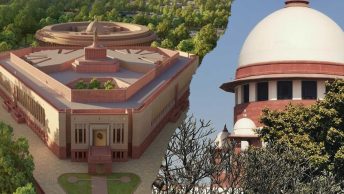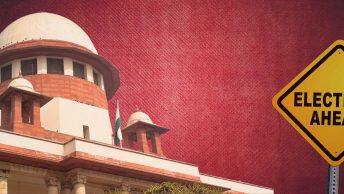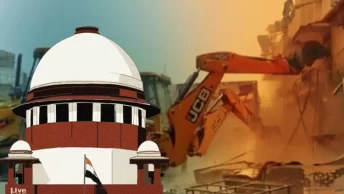On 5th August 2019, the President of India passed The Constitution (Application to Jammu and Kashmir) Order, 2019 [“C.O. 272”]. This Order, while brief, has monumental implications for the decades-old Kashmir crisis. Its effects include the effective scrapping of Article 370 of the Constitution of India (“Constitution”) and a potential bifurcation of the State of Jammu and Kashmir into the Union Territory of Ladakh and the Union Territory of Jammu and Kashmir. This move was prefaced by an almost week-long series of modifications to arrangements qua travel, tourism, communication and security in the State. Such steps included the cancellation of the annual Amarnath Yatra (and a consequent direction to tourists to move out of the State), suspension of high-speed internet services, the deployment of additional security troops, the placing under house arrest of former J&K Chief Ministers Omar Abdullah and Mehbooba Mufti, and the implementation of a state-wide curfew under Section 144 of the Code of Criminal Procedure (CrPC), among other things.
This piece seeks to explain Jammu and Kashmir’s constitutional status in light of the developments of 5th August 2019.
Jammu & Kashmir’s Constitutional Status Prior to C.O. 272
Article 370 was passed in light of the Instrument of Accession, by which the princely state of Jammu and Kashmir formally acceded to the Indian Union. Article 370 was envisaged as a temporary provision, to be in force until the Constituent Assembly of the State had drafted a Constitution for the State[1]. However, the Constitutent Assembly of the State was dissolved in 1957, and Article 370 has continued to occupy a place in the bare text of the Constitution all these years.
Prior to the passing of C.O. 272, the relevant portion of Article 370 read thus:
370. Temporary provisions with respect to the State of Jammu and Kashmir
(1) Notwithstanding anything in this Constitution,
(d) such of the other provisions of this Constitution shall apply in relation to that State subject to such exceptions and modifications as the President may by order specify: Provided that no such order which relates to the matters specified in the Instrument of Accession of the State referred to in paragraph (i) of sub clause (b) shall be issued except in consultation with the Government of the State: Provided further that no such order which relates to matters other than those referred to in the last preceding proviso shall be issued except with the concurrence of that Government
(2) If the concurrence of the Government of the State referred to in paragraph (ii) of sub clause (b) of clause (1) or in the second proviso to sub clause (d) of that clause be given before the Constituent Assembly for the purpose of framing the Constitution of the State is convened, it shall be placed before such Assembly for such decision as it may take thereon
(3) Notwithstanding anything in the foregoing provisions of this article, the President may, by public notification, declare that this article shall cease to be operative or shall be operative only with such exceptions and modifications and from such date as he may specify: Provided that the recommendation of the Constituent Assembly of the State referred to in clause (2) shall be necessary before the President issues such a notification
As per Article 370(1)(d), the President can, through orders, modify the application of the Constitution to the state of J&K. A significant consequence of the exercise of this power was the promulgation of Article 35A, which was inserted into the Constitution vide the Constitution (Application to Jammu and Kashmir) Order, 1954. This Order also extended certain fundamental rights of the Indian Constitution to the State, along with the extension of the Supreme Court’s jurisdiction over it. The insertion of Article 35A was peculiar in that it was the result of the President exercising his powers under Article 370, and not of the Parliament amending the Constitution under Article 368. The text of Article 35A read thus:
35A. Saving of laws with respect to permanent residents and their rights. —
Notwithstanding anything contained in this Constitution, no existing law in force in the State of Jammu and Kashmir, and no law hereafter enacted by the Legislature of the State:
(a) defining the classes of persons who are, or shall be, permanent residents of the State of Jammu and Kashmir; or
(b) conferring on such permanent residents any special rights and privileges or imposing upon other persons any restrictions as respects—
(i) employment under the State Government;
(ii) acquisition of immovable property in the State;
(iii) settlement in the State; or
(iv) right to scholarships and such other forms of aid as the State Government may provide,
shall be void on the ground that it is inconsistent with or takes away or abridges any rights conferred on the other citizens of India by any provision of this part.
Article 35A gave the state legislature of Jammu and Kashmir the power to classify persons as permanent/non-permanent residents of the State, which then had the effect of granting an advantage to the “permanent residents” qua acquiring property, getting government jobs, settling in the state and being eligible for scholarships/academic aid.
The Kashmir Quandary
The special constitutional status of Kashmir has been a source of great controversy and, consequently, litigation, over the years. Article 35A has presently been challenged before the Supreme Court (albeit C.O. 272, as the following section shall show, renders this challenge infructuous) on the grounds that it violates Article 14 of the Constitution (which guarantees all persons equality before the law) for creating a classification between permanent and non-permanent citizens and between women and men qua the acquisition of immovable property; that it was an improper exercise of the President’s power under Article 370(1)(d), and that it violated the “basic structure” of the Constitution.
Across the country, several instances of Kashmiris being treated with hostility in the Indian mainland have been reported over the years, and frequent clashes between separatists and security forces in Kashmir, as also those resorting to militancy, have largely characterized discussions on the region’s social environment.
What has C.O. 272 Changed?
By this order, the President has, in exercising the power granted to him by Article 370(1)(d) of the Constitution, extended the operation of all the provisions of the Constitution to the State of Jammu and Kashmir. Also, vide the same provision, additional provisions have been added to Article 367 of the Constitution and made applicable to the State of Jammu and Kashmir. Article 367 is a provision that aids the interpretation of certain provisions of the Constitution. The order provides for any reference to the Sadar-i-Riyasat to mean a reference to the governor; also, the government of the state has now been deemed to include the Governor acting on the aid and advice of the council of ministers. Further, it has provided that, for the purposes of Article 370(3) (which enables the repeal of Article 370 by the President with the concurrence of the “Constituent Assembly”), a reference to the constituent assembly has includes a reference to the state legislative assembly. It is interesting to note that Article 370 has not, as yet, been formally scrapped. It only stands effectively scrapped, owing to the extending of all Constitutional provisions, with some qualifications, to the state of J&K. A proposal for its scrapping is pending in the Parliament.
This order superseded the Presidential Order of 1954; thus, another major consequence of C.O. 272 is the removal of Article 35A, which enabled the State of Jammu and Kashmir to create special provisions for the permanent residents of Jammu and Kashmir at the exclusion of non-permanent residents, importantly with regard to employment under state government and acquisition of immovable property.
Possible Ramifications
The repeal of the 1954 Presidential Order, and consequently Article 35A, means that the special protection to permanent residents will now cease to exist. As a result, the non-permanent residents including people from other states will be able to take up state employment and acquire properties, among other things. This will surely be met with resistance from the residents of Jammu and Kashmir, as being a threat to job opportunities and as having the potential for land being taken over for ostensibly “developmental” or commercial purposes. Another concern among the locals could be the threat of being reduced to a minority, with the restrictions on influx of others into the state having now been lifted. The net result of all this on the ground could be the fomenting of widespread, and possibly violent, protests. However, the mobilizing of protests might be hindered by the imposition of Section 144 of the CrPC, which is in place at the moment. On the other hand, there are also proponents who say that the effective opening up of the State could lead to higher investments and growth in the region, and the conclusive integration of the state in the Indian Union, an assertion that will have to stand the test of time.
The modification of Article 367 is a precursor to two things: a proposed Statutory Resolution, and the Jammu and Kashmir Reorganisation Bill. The Statutory Resolution introduced in the Rajya Sabha recommends that the President abrogate Article 370. Previously, the President could not have done this easily, as Article 370(3), which provides for a procedure to repeal Article 370, mandates a recommendation from the constituent assembly of Jammu and Kashmir. However, after Article 367 has been modified (as explained above), “constituent assembly” would now mean State Assembly, and since the state is presently under the President’s rule, the powers of the state assembly are vested with the Parliament. As a result, Article 370 could be abrogated by an order of the President on the recommendation of both houses of the Parliament. An obvious anomaly in this scheme of affairs is that, effectively, the concurrence of the constituent assembly in the repeal of Article 370 has now been replaced by the concurrence of the Parliament (since the state is under President’s rule); thus, the Parliament has effectively sought to grant concurrence/consent to the President for a move that, at their behest, is binding on the President (since the President, per Article 74 of the Constitution is bound by the advice of the council of ministers).
Once Article 370 is abrogated, Jammu and Kashmir would be like any other Indian state and the Parliament could, under Article 3, redraw its boundaries and create a new Union Territory, which is what the Jammu and Kashmir Reorganisation Bill seeks to do. The first proposed Union Territory is Jammu and Kashmir, which is to have a legislative assembly and the second is Ladakh, which is to be sans a legislative assembly. If the Bill were to pass, the णentre would enjoy a great degree of control in the state of affairs of Jammu and Kashmir, importantly with regard to law and order.
There is a case to be made to the effect that Article 370 was always a temporary provision, as evidenced by an explicit indication to that effect within the text and by the fact that the Constituent Assembly that it envisaged dissolved in 1957. However, there is also a case to be made that Article 370 has attained a permanent character, and scrapping it would strike at the very heart of the Instrument of Accession that binds Kashmir’s accession to India.
It would be interesting to keep track of the resolution recommending the formal abrogation of Article 370 and the Reorganisation Bill, and the potential litigation that could follow, assailing all the developments of 5th August 2019. Important days lie ahead for the Indian nation and her Constitution, and all we can do is wait, watch and hope for the best.
UPDATE: The resolution that recommended to the President the abrogation of Article 370 has been substantially passed, with the President formally amending the same to almost completely rid it of its original form, with the effect of the amended Article now meaning that all Constitutional provisions are now to be applied to the State of J&K, notwithstanding contradictory provisions in, inter alia, the Indian and J&K Constitutions. Further, the Jammu and Kashmir Reorganisation Bill has been passed by the Parliament, thus paving the way for the creation of the Union Territories of Ladakh (without a legislative assembly) and Jammu and Kashmir (with a legislative assembly).
UPDATE 2: The President of India has given assent to the Jammu and Kashmir Reorganisation Act, 2019, and will come into effect on the 31st of October, 2019 [appointed date].
Jammu and Kashmir Reorg Act 2019appointed date
[1] A. G. Noorani, Article 370: A Constitutional History of Jammu and Kashmir, Oxford University Press (2011)







